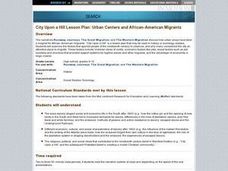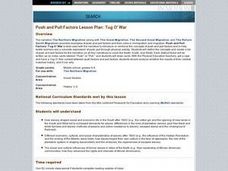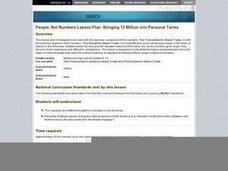Curated OER
Home Ties
Students explore the reasons people choose to migrate including political, economic and familial motivations. They interview family members and compare their ancestors own reasons for migration to those of African American urban migrants.
Curated OER
Why People Move
Fourth graders investigate within their family structure where their relatives have moved or migrated from. They compare/contrast this data with other students. Students map out their finding. They interview family members.
Curated OER
City Bound
Fifth graders identify the reasons for people migrating to cities after the Civil War. Using population data, they discover why populations in cities rose while rural populations fell during 1860 to 1900. They discuss the impact a...
Curated OER
The People of Kansas: Where Did They Come From and Why Did They Come?
Pupils research and discuss the reasons why early settlers emigrated to Kansas. They, in groups, analyze census district reports from the 1850's and then identify the advantages and disadvantages of using this information as research.
Curated OER
The Origins of Man
Young scholars learn about new technologies being used to update what is known about human evolution and migration. They then compare the new theories to the traditional knowledge.
Curated OER
Why Milton Hershey Chose Derry Township to Build His Factory
Middle schoolers determine how push/pull factors convinced Milton Hershey to build his chocolate factory in Derry Township. In this geography skills lesson, students complete an anticipation guide, read about push/pull factors, and...
Curated OER
Influence of Geography on the Migration of Virginians
Sixth graders study how geography influenced the westward migration of Virginians. They review the settlement patterns of early Virginians before discussing reasons why people move away from an area. Looking at maps, they determine how...
Learning to Give
Humphrey The Lost Whale
The children's book Humphrey the Lost Whale tells an amazing tale of a community joining together for a common cause. Read this book with your class, making connections between the events in the story and personal experiences of young...
Curated OER
The Study of the Spanish-Speaking People of Texas: Immigration
Students identify the meaning of the following terms: immigrant, immigration, migrate, and assimilation. They identify reasons that immigrant groups came to Texas and explain where groups settle and the influence these groups have on...
Curated OER
Hole Hole Bushi
Fourth graders play a written rhythm pattern. They state when a rhythm pattern varies from a given pattern by listening to an ostinato. They state reasons why people migrate to different lands.
Howard Hughes Medical Institute
Zebrafish and Skin Color
You may not know if that zebrafish in your fish tank is a model citizen—but it is definitely a model organism! What can we learn about ourselves from a tiny zebrafish? Discover more about the polygenic trait of skin color through a...
Curated OER
Exploring Gullah Culture...Through Language and Numbers
First graders examine the culture of the ancient Gullah people. As a class, they practice saying and writing the days of the week and numbers in Gullah. They are read a Gullah folktale and put the events of the story into the correct...
Curated OER
Migration and Refugees
Students explore issues relating to refugees. Using the internet, they gather facts about refugees. Students discuss the range of situations which turn citizens of one country into refugees of another.
Constitutional Rights Foundation
History of Immigration Through the 1850s
Everyone living in the United States today is a descendant from an immigrant—even Native Americans. Learn about the tumultuous history of American immigration with a reading passage that discusses the ancient migration over the Bering...
Curated OER
Get Ready, Get Set, Hibernate
Students match each body part or idea from a work bank about methods of animal adaptations for winter survival. They observe as the first one, food is covered with the whole class before completing the rest of the diagram. They discuss...
Curated OER
City Upon a Hill: Urban Centers and African-American Migrants
Students examine why fugitive slaves migrated to cities and towns rather than rural areas. In this lesson, students consider the social, economic, and political benefits provided by cities and towns in comparison to rural areas.
Curated OER
Push and Pull Factors: Tug O' War
Pupils analyze the factors that led to migration in the 19th century including the forces that drew people to resettle as well as to return a place where they previously lived.
Curated OER
Early Explorers
Fifth graders investigate the routes taken by the early explorers. In this explorers lesson, 5th graders use interactive notebooks, discussion and maps to discover the routes taken. Students get into pairs and label maps, and create...
Alabama Learning Exchange
Our World is Like a Rainbow
Young scholars create a Venn diagram of people's similarities and differences. They investigate why people relocate to different geographic regions after investigating the positives and negatives of different states.
Curated OER
Immigration in the United States
Pupils examine the reasons why people leave their country to live in another. In groups, they use print and electronic resources to answer questions about where immigrants came from during different time periods and advice given to...
Curated OER
Fertilizers, Pesticides and Human Health- American Lessons
Students explore migration and why people move. They explore the movement of native populations. Students explore the economy as an factor in migration. They discuss the exploitation of the migrant worker.
Curated OER
Immigration and American Life on African-Americans
Students examine how human migration started in Africa, and draw maps of Africa and place the names of the countries and capitals on the maps. They write essays on how Africans came to America.
Curated OER
People, Not Numbers: Bringing 12 Million into Personal Ter
Young scholars forge a compassionate link to the large numbers of people who were the victims of slavery as opposed to thinking of them simply in terms of numbers. They perform a math exercise to put the number of people in slavery into...
Curated OER
The Market for Moving People to America, 1610-1775
Students examine the markets that brought people to America. They identify the role of the immigrants in creating this country. They also analyze data to gather information about the time period.

























